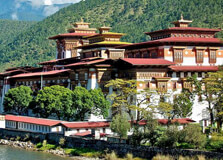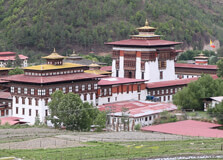
- Home
- Travel Packages
- Top Destination
-
Travel Attraction
By Category
Top Attraction

- Travel Agents
- Car Rentals
- Hotels

Punakha Dzong is one of Bhutan’s most majestic and historically significant dzongs (fortresses). Located in the Chukha district, it is situated at the confluence of the Pho Chhu (Male River) and Mo Chhu (Female River), surrounded by stunning natural beauty. This dzong has played a crucial role in Bhutan’s history as a religious, administrative, and military center. It is the second oldest dzong in Bhutan and served as the country’s capital until 1955 before Thimphu took over the role. The dzong is not only an architectural marvel but also a vibrant religious hub, housing many monks and hosting important ceremonies and festivals throughout the year. How to Reach Punakha Dzong, Chukha Punakha Dzong is accessible by road and is approximately 77 kilometers from Paro Airport, Bhutan’s main international gateway. The drive to Punakha takes around 3 hours, passing through beautiful mountain landscapes and the famous Dochula Pass, which offers panoramic views of the Himalayan peaks. Visitors can hire taxis or join guided tours from Thimphu or Paro to reach Punakha. The roads are generally in good condition, though during monsoon season some parts may be slippery. It’s advisable to start early in the day to enjoy the journey and the sights along the way. Weather at Punakha Dzong, Chukha The climate in Punakha is relatively warm and pleasant compared to other parts of Bhutan, thanks to its lower altitude (about 1,200 meters). Summers are warm with occasional monsoon rains from June to September, which transform the surrounding valleys into lush greenery. Winters are mild and comfortable, making it an ideal time for visitors who prefer cooler weather. The best time to visit is during spring (March to May) when rhododendrons bloom or autumn (September to November) when the weather is clear and festivals are held. Timing Punakha Dzong is generally open to visitors between 9:00 AM and 5:00 PM. It is recommended to visit early in the day to avoid crowds and enjoy the peaceful surroundings. Since it is an active religious site, visitors should be respectful of prayer times and ceremonies. Why Famous for Punakha Dzong, Chukha? Punakha Dzong is famous for its stunning architecture, historical importance, and religious significance. It is known as the "Palace of Great Happiness" and has been the site of many key events in Bhutanese history, including the coronation of the first King of Bhutan in 1907. The dzong houses sacred relics of the Drukpa Kagyu school of Buddhism and serves as the winter residence for the Central Monastic Body of Bhutan. Its beautiful location by the river and impressive fortress walls make it one of Bhutan’s most photographed landmarks. Entry and Visit Details about Punakha Dzong, Chukha Visitors are required to pay a small entry fee to visit Punakha Dzong. The fee helps maintain the dzong and support the monastic community. Visitors should dress modestly, covering shoulders and knees, as a sign of respect. Photography is allowed in the outer areas but restricted inside the prayer halls. Guided tours are available and highly recommended to better understand the dzong’s history, architecture, and religious importance. History and Architecture Punakha Dzong was constructed in 1637-38 by Ngawang Namgyal, the 1st Zhabdrung Rinpoche, who unified Bhutan as a nation-state. Built strategically at the confluence of two rivers, it served both as a fortress and administrative center. The dzong exemplifies traditional Bhutanese architecture with massive stone walls, ornate wooden carvings, intricate murals, and golden roofs. It is designed to withstand floods, earthquakes, and invasions, having been restored multiple times after natural disasters. Inside the dzong are several temples, monks’ quarters, and government offices, arranged harmoniously in a compact but expansive layout. The central tower or "utse" houses sacred relics and is the spiritual heart of the dzong. Things to Do at Punakha Dzong Explore the Dzong: Wander through the grand courtyards, temples, and corridors while admiring the intricate artwork and architecture. Attend Festivals: Witness the famous Punakha Tshechu and Domchoe festivals featuring traditional mask dances and rituals. Photography: Capture stunning views of the dzong against the backdrop of the rivers and surrounding hills. Visit Suspension Bridge: Walk across the nearby Punakha Suspension Bridge, one of the longest in Bhutan, offering spectacular views of the valley. Nature Walks: Explore the nearby rice fields and riverside trails for a peaceful experience. Facts about Punakha Dzong Punakha Dzong is the second oldest dzong in Bhutan and one of the most architecturally significant. It was the site of Bhutan’s first king’s coronation in 1907. The dzong is built to protect against floods, with massive walls and elevated foundations. The nearby Punakha Suspension Bridge is a famous landmark and a popular tourist spot. The dzong serves as the winter residence for the Je Khenpo (Chief Abbot) and monks. Tips for Visiting Punakha Dzong, Chukha Wear comfortable shoes suitable for walking on uneven stone floors. Dress modestly and respectfully, covering shoulders and knees. Carry water and sun protection, especially during warmer months. Hire a local guide to enrich your visit with historical and cultural insights. Visit early in the morning or late afternoon to avoid crowds and enjoy softer lighting for photography. Check festival dates if you want to experience traditional Bhutanese religious events. Be respectful inside the dzong by speaking softly and avoiding flash photography in temples.
Explore More
Tashichho Dzong is a majestic and historically significant fortress-monastery located in the Chukha district of Bhutan. This impressive structure serves as both a religious center and an administrative hub. Dzongs are a unique feature of Bhutanese architecture, combining fortress-like elements with sacred monastic functions, and Tashichho Dzong is one of the finest examples. The Dzong plays a central role in Bhutan's spiritual and political life, housing several government offices, the throne room of the King, and the central monastic body. With its commanding position overlooking the surrounding landscape, it stands as a symbol of Bhutanese heritage, culture, and tradition. How to Reach Tashichho Dzong, Chukha Tashichho Dzong is accessible by road and is conveniently located near the town centers in Chukha district. For visitors traveling from Thimphu, the capital city, the Dzong is about 5 kilometers away and easily reachable by taxi or local transport. The road is well-maintained, making it a quick and comfortable trip. International travelers typically fly into Paro International Airport, which is approximately 50 kilometers from Tashichho Dzong. From Paro, visitors can hire a taxi or arrange a tour that includes transportation to the Dzong. Weather The weather around Tashichho Dzong varies with the seasons but is generally mild due to its moderate elevation. Spring (March to May) and autumn (September to November) are the best times to visit, offering clear skies, pleasant temperatures, and vibrant natural surroundings. Summers can be warm and humid, with occasional monsoon rains making travel less comfortable. Winters (December to February) are cooler but rarely harsh, though visitors should bring layers to stay warm, especially in the evenings. Timing Tashichho Dzong is open to visitors typically from 9:00 AM to 5:00 PM daily, but it's best to confirm current visiting hours before your trip as timings can sometimes change due to religious events or government functions. Visitors are advised to plan their visit during the day to fully appreciate the architectural beauty and participate in guided tours or ceremonies that may be taking place. Why Famous for Tashichho Dzong, Chukha? Tashichho Dzong is famous for several reasons. It serves as the summer residence of Bhutan's monastic body, including the Je Khenpo, the chief abbot of Bhutan. The Dzong is also a crucial administrative center, housing government offices such as the Ministry of Home and Cultural Affairs. The Dzong is renowned for its stunning Bhutanese architecture — its massive whitewashed walls, red roofs, intricate woodwork, and ornate interiors reflect centuries-old craftsmanship. It also hosts important religious festivals such as the annual Tsechu, which draws locals and tourists to witness traditional mask dances and cultural rituals. Entry and Visit Details about Tashichho Dzong, Chukha Visitors can enter Tashichho Dzong with a guided tour or on their own during visiting hours. Entry is usually free, but certain parts of the Dzong may be restricted due to ongoing government activities or monastic functions. Photography is generally allowed in the courtyard and exterior but may be restricted inside prayer halls or sensitive areas. Visitors should dress respectfully and remove shoes when entering religious spaces. Silence and respectful behavior are expected throughout the Dzong. History and Architecture Tashichho Dzong was originally built in 1641 by Zhabdrung Ngawang Namgyal, the unifier of Bhutan. It has undergone several renovations over the centuries due to damage from fire and natural wear but has maintained its historical essence and grandeur. The architecture of Tashichho Dzong is typical of Bhutanese dzongs, featuring massive fortress walls, courtyards, and towering watchtowers. The whitewashed walls are contrasted by elaborately painted woodwork and golden roofs. Inside, the Dzong houses several temples with intricate murals, statues, and altars. The Dzong’s layout is designed to serve both defensive and spiritual purposes. Its location on a hill overlooking the surrounding valley provided strategic advantages in the past and now offers panoramic views that visitors cherish. Things to Do at Tashichho Dzong, Chukha Visitors to Tashichho Dzong can enjoy a variety of activities: Explore the Dzong Architecture: Wander through courtyards, admire wood carvings, and learn about the traditional Bhutanese construction techniques. Attend Religious Ceremonies: If visiting during festival times, watch vibrant mask dances and rituals that bring the Dzong alive with colors and sounds. Photography: Capture stunning shots of the Dzong’s exterior, especially at sunrise or sunset when the light highlights its details. Learn about Bhutanese History: Guided tours provide insights into the Dzong’s role in Bhutan’s political and religious history. Enjoy Scenic Views: The elevated location offers breathtaking views of the surrounding valleys and mountains. Facts and Tips about Tashichho Dzong, Chukha Here are some useful facts and tips for visitors: The Dzong serves as the office of the King of Bhutan’s throne room during certain occasions. Visitors should dress modestly and avoid wearing hats or sunglasses inside religious areas. Respect the monastic community and avoid loud conversations or disruptive behavior. It is best to hire a local guide to gain deeper understanding of the Dzong’s significance and hidden stories. Carry some water and light snacks, as there are limited facilities inside the Dzong complex. Wear comfortable shoes for walking on uneven stone pathways. Check the calendar for festival dates like the Tsechu for a culturally immersive experience. Do not touch religious artifacts or interfere with ongoing prayers and rituals. In conclusion, Tashichho Dzong in Chukha is not only an architectural marvel but also a living symbol of Bhutan’s religious devotion and governance. It offers visitors a unique opportunity to witness Bhutanese culture firsthand while enjoying the serene and majestic surroundings.
Explore More